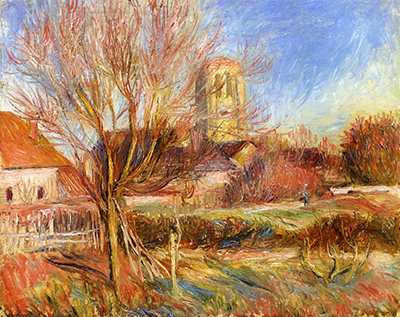The Church at Essoyes, an oil-on-canvas painting, is a fascinating work of art by a renowned Impressionist French painter, Pierre-Auguste Renoir
As its name suggests, the portrait depicts a church in the serene 19th-century French countryside. Sitting on a raised place surrounded by awe-inspiring scenery, Noir’s church evinces a deeper wonder that has characterised man’s interest in the Supreme Being since time immemorial.
Religious architecture has long been a source of inspiration for artists right across the world. Vincent van Gogh's Church at Auvers is amongst the most famous. Internally, Michelangelo produced brilliance within the Sistine Chapel including his The Last Judgement fresco that sits above the altar.
The church has always been at the centre of human existence, a concept not lost to Renoir and his works of art. In this picture, the church captures the imagination of the audience owing to the prominent position it receives from the artist.
Being an enthusiast of nature and natural beauty, it was only natural that Pierre would incorporate it into his Impressionist works. The natural scenery surrounding the church is attractive to the eye and creates a sense of peace and harmony, and Noir seems to have had the intention to convey to his audience that Christianity at Essoyes represented peace and harmony.
Pierre-Auguste Renoir created The Church at Essoyes during the era of impressionism which happened in the 19th century. During this period the artwork and paintings were significantly advanced by using an opaque background to applying the paint to a light or white background.
The Impressionists used this technique to make the colour appear more vivid to the viewer, allowing them to connect with the artwork. Pierre was among the small group of painters who adopted Impressionism to give their paintings a new dimension.
In the 19th-century new technology had emerged in the painting industry and hence painters embraced the impressionism style and techniques of painting. Pierre started his career as a porcelain painter, but as Impressionism swept across Europe, he advanced his artwork and produced The Church at Essoyes portrait.
Various techniques used to create and illustrate the theme of the portrait include painting the blue of the sky which gives a sense of freshness to the image. Also, the use of thick and short strokes of paints helps to create the air of peace and serenity. Pierre uses more techniques to create the great artwork, the reflection of colours from object to object while emphasizing natural light. Also, he uses the method of placing wet paint on wet paint hence creating softer edges and allowing colours to intermingle.
The French painter associated himself with impressionists in the 19th century and became one of the central figures of the movement. His experience and love for nature enabled him to infuse a sense of the richness of feeling and great warmth to his images, as is the case for The Church at Essoyes. However, despite impressionism technique resulting in great portraits, Pierre left the movement since he wanted to create more interesting images by applying more disciplined and formal methods such as figure painting.
The church at Essoyes connects the audience to Pierre through his depiction of the serenity that surrounds the church. The French painter was so much in love with nature the surroundings at Essoyes that he buried most of his family here.




